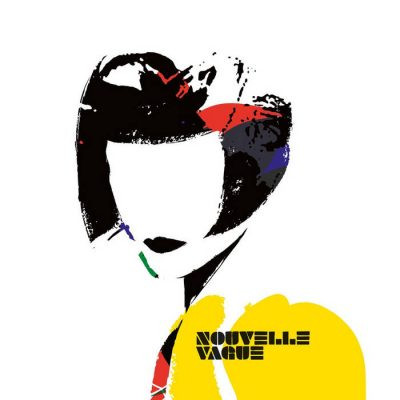Nouvelle Vague, the French band famed for their unique bossa nova interpretations of punk and new wave classics, is back with a new album aptly titled Should I Stay or Should I Go? For long-time fans and newcomers alike, the question might well be: should they continue to explore this well-trodden path, or is it time for a new direction? In their heyday, Nouvelle Vague’s concept was undeniably captivating, breathing fresh, sophisticated samba rhythms into the raw energy of post-punk anthems. But in today’s musical landscape, does this formula still hold its original charm? This new release prompts us to delve into whether Nouvelle Vague’s signature sound remains innovative or if it’s becoming a nostalgic echo of its former brilliance. This review explores the latest offering, track by track, to determine if Should I Stay or Should I Go? is a welcome return or a step too far into revisiting the past.
 Nouvelle Vague Should I Stay or Should I Go Album Cover featuring band members in a retro style
Nouvelle Vague Should I Stay or Should I Go Album Cover featuring band members in a retro style
The album opens with “What I Like Most About You Is Your Girlfriend,” originally by The Specials. While Nouvelle Vague often excels at transforming genres, here, the samba rendition feels somewhat uninspired. The irony, which was subtly present in The Specials’ ska-infused original, is flattened out in this overly simplified, easy-listening version. Depeche Mode’s “People Are People” follows, and unfortunately, it too falls into a similar languidness. The track sounds weary, losing the original’s poignant social commentary in favor of a cocktail-hour melancholy that feels more tired than sophisticated.
However, the album isn’t without its moments of brilliance. “You Spin Me Round” by Dead or Alive is reimagined with a Big Spender-esque theatricality that is genuinely surprising and delightful. The over-the-top arrangement cleverly disguises the song initially, leading to a satisfying “aha!” moment when the chorus hits. This track marks a noticeable shift towards a fuller studio band sound, a departure from the more minimalist electronica of Nouvelle Vague’s earlier albums. Another standout is their take on Bauhaus’s “She’s In Parties.” Perhaps because the original is less ubiquitous, the cover offers a more striking contrast. It evokes a brooding, almost gothic atmosphere, reminiscent of Roxy Music’s “In Every Dream Home A Heartache,” showcasing a welcome touch of darkness.
ABC’s “The Look Of Love” is another highlight, seamlessly blending the 80s hit with a subtle nod to Timmy Thomas’s “Why Can’t We Live Together.” The result is stylish and sophisticated, particularly the drawn-out pronunciation of “loooook.” It even hints at a connection to Burt Bacharach’s song of the same name, famously sung by Dusty Springfield, adding layers of musical history. However, this high point is followed by a less successful experiment: Tears For Fears’ “Shout.” The reggae-tinged rendition feels awkward, with clumsy horn arrangements that sound jarringly tacked on, almost lifting from Elvis Costello’s “Watching The Detectives.” The usually rousing chorus feels forced and lacks the original’s anthemic power.
The album’s title track, “Should I Stay or Should I Go?” originally by The Clash, takes a curious turn with Speedy Gonzalez and caramba inflections. As the song progresses, it veers into frankly embarrassing territory, with mariachi trumpets and Hombre bravos-style backing vocals. It’s a misstep that undermines the iconic punk energy of the original. Fortunately, Nouvelle Vague recovers with Billy Idol’s “Rebel Yell,” transformed into a yé-yé infused delight. This cover injects quirky new life into the familiar rock anthem, utilizing vibes and possibly electric piano to create an unexpected charm. The contrast between the aggressive lyrics and the breezy delivery is both clever and effective. Continuing this positive streak, The Associates’ “Breakfast” is treated with a relatively straight, “Bond movie soundtrack” approach, wisely avoiding any attempt to emulate Billy Mackenzie’s unique vocal theatrics. The vocal tone here is appropriately diva-esque, reminiscent of Shirley Bassey, where performance takes precedence over straightforward singing.
Duran Duran’s “Girls On Film” flirts with a Bond theme atmosphere, and while it comes close to succeeding, it’s ultimately let down by an overly mannered vocal performance. Blondie’s “Rapture,” however, is a surprising triumph. It’s a deconstructed and reconstructed version that nearly nails the original’s innovative blend of genres. The only letdown is the spoken section, which, unlike Debbie Harry’s rap in the original, feels messy and detracts from the initial listening pleasure. A redeeming feature is an unexpected trombone solo. The album concludes with The Smiths’ “This Charming Man.” One might expect The Smiths to translate effortlessly to bossa nova given Morrissey’s crooning style, which already shares some similarities with Antonio Carlos Jobim. However, this rendition, complete with a somewhat bizarre rooster crowing sound effect, descends into a cocktail lounge level of Latin jazz that feels more like a mocktail than the real deal.
Ultimately, Should I Stay or Should I Go? presents a mixed bag. While there are moments of genuine innovation and delightful reinterpretations, particularly in tracks like “You Spin Me Round,” “She’s In Parties,” and “Rebel Yell,” other tracks feel uninspired or even misjudged. There’s perhaps a strong EP’s worth of compelling material within this collection. So, to answer the album’s titular question: should you stay or should you go when it comes to listening to this new Nouvelle Vague release? For dedicated fans, there are definitely tracks worth exploring. For newcomers, it might be a less compelling entry point compared to their earlier, more consistently innovative work. Whether this album marks a creative resurgence or signals a need for Nouvelle Vague to consider a new direction remains, much like the album title suggests, a question of whether to stay or to go.

